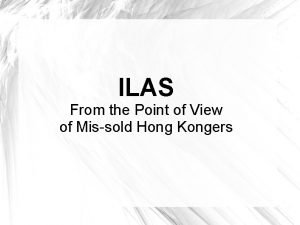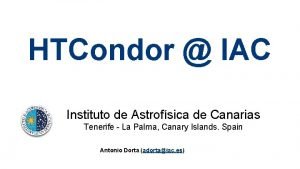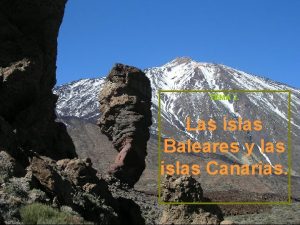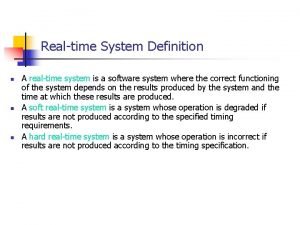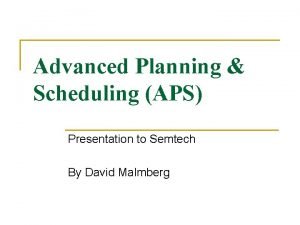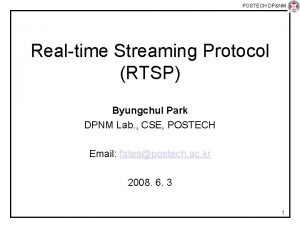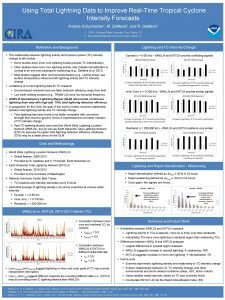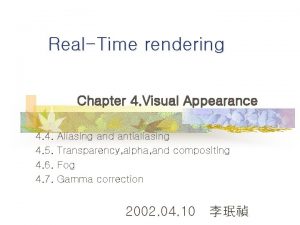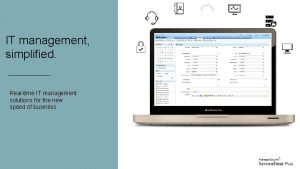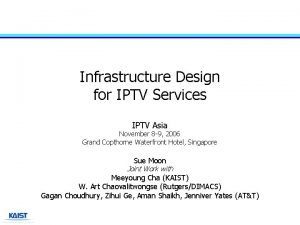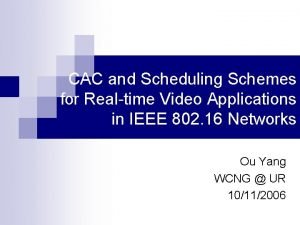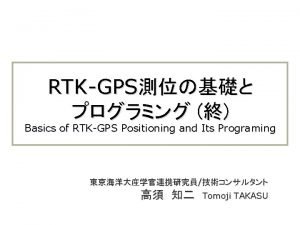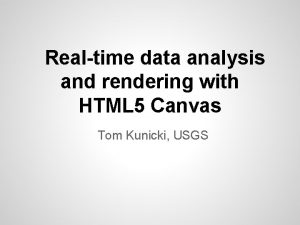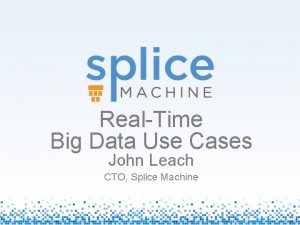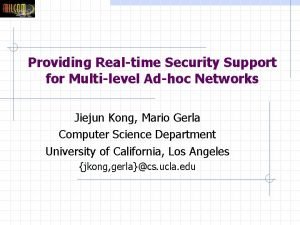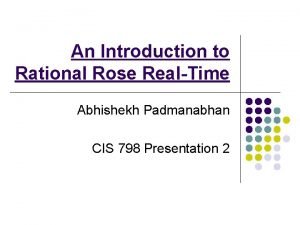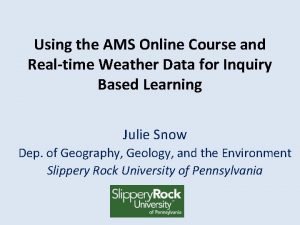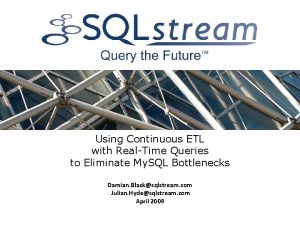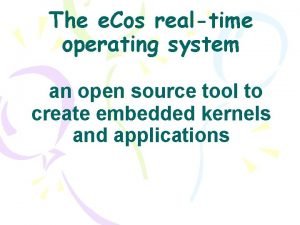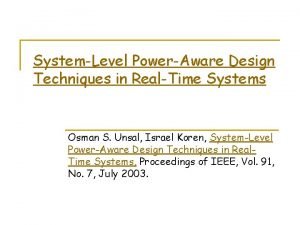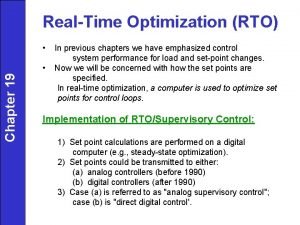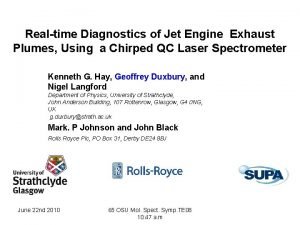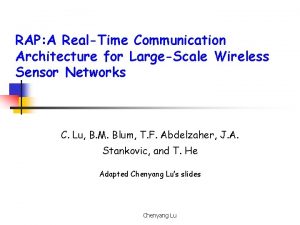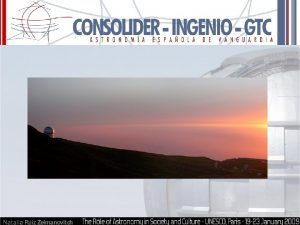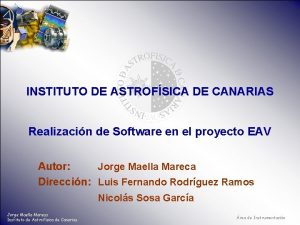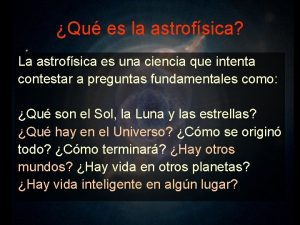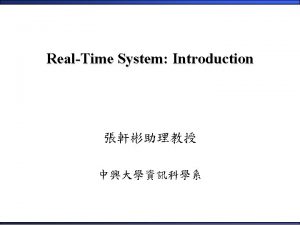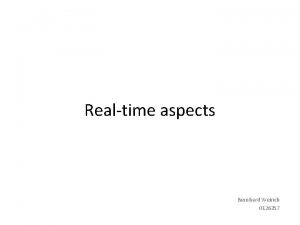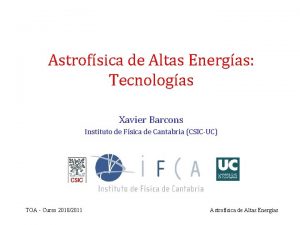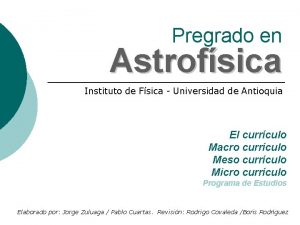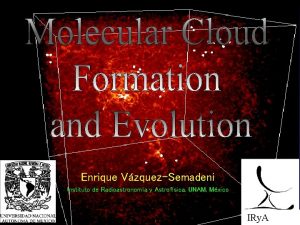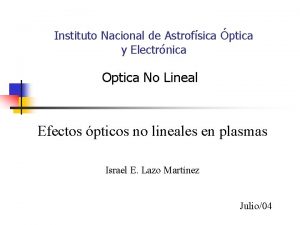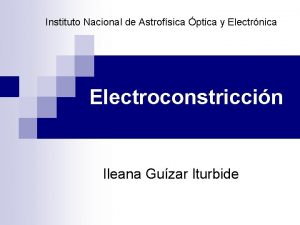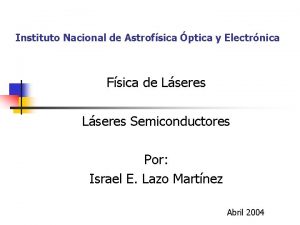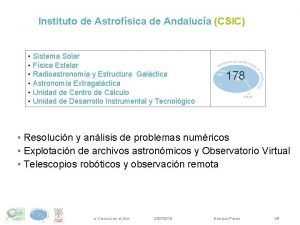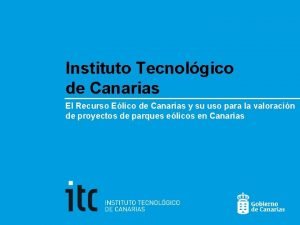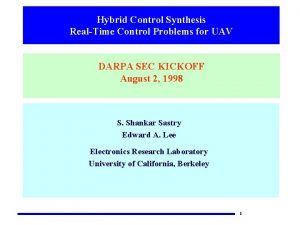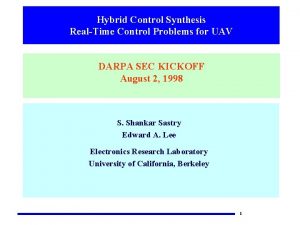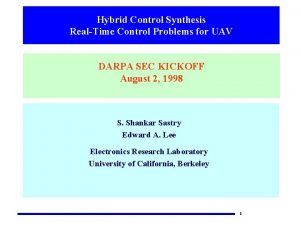INSTITUTO DE ASTROFSICA DE CANARIAS Realtime control with


































- Slides: 34

INSTITUTO DE ASTROFÍSICA DE CANARIAS Real-time control with FPGA, GPU and CPU at IAC Paris, 2016 -01 -26 Luis Fernando Rodríguez Ramos Instituto de Astrofísica de Canarias Paris RTC Workshop

Contents Ø Ø Ø Introduction Brief review of ongoing IAC Adaptive Optics projects Summary of control technologies used Technologies comparison Conclusions Luis Fernando Rodríguez Ramos Instituto de Astrofísica de Canarias 2 Technology Division

Contents Ø Ø Ø Introduction Brief review of ongoing IAC Adaptive Optics projects Summary of control technologies used Technologies comparison Conclusions Luis Fernando Rodríguez Ramos Instituto de Astrofísica de Canarias 3 Technology Division

EDi. Fi. SE Luis Fernando Rodríguez Ramos Instituto de Astrofísica de Canarias 4 Technology Division

EDi. Fi. SE Laboratory setup Luis Fernando Rodríguez Ramos Instituto de Astrofísica de Canarias 5 Technology Division

EDi. Fi. SE GUI Luis Fernando Rodríguez Ramos Instituto de Astrofísica de Canarias 6 Technology Division

EDi. Fi. SE RTC physical block diagram • 500 Hz • 16 x 16 SH WFS • 97 actuators Luis Fernando Rodríguez Ramos Instituto de Astrofísica de Canarias 7 Technology Division

EDi. Fi. SE FPGA RTC Luis Fernando Rodríguez Ramos Instituto de Astrofísica de Canarias 8 Technology Division

EDi. Fi. SE Movie Luis Fernando Rodríguez Ramos Instituto de Astrofísica de Canarias 9 Technology Division

AOLI Luis Fernando Rodríguez Ramos Instituto de Astrofísica de Canarias 10 Technology Division

AOLI RTC physical arrangement WFC 1 Connection box Driver DM Digital I/O GPU K 40 • 100 Hz • Geometric curvature WFS • 241 actuators Frame grabber WFC 2 Desktop computer Luis Fernando Rodríguez Ramos Instituto de Astrofísica de Canarias 11 Technology Division

AOLI GUI Luis Fernando Rodríguez Ramos Instituto de Astrofísica de Canarias 12 Technology Division

AOLI Laboratory testing Luis Fernando Rodríguez Ramos Instituto de Astrofísica de Canarias 13 Technology Division

GTCAO Luis Fernando Rodríguez Ramos Instituto de Astrofísica de Canarias 14 Technology Division

GTCAO Laboratory integration Luis Fernando Rodríguez Ramos Instituto de Astrofísica de Canarias 15 Technology Division

GTCAO RTC block diagram WFC (OCAM 2) DM s. FPDP I/F Frame grabber • 1500 Hz • 20 x 20 SH WFS • 373 actuators Driver Rack mounted computer Luis Fernando Rodríguez Ramos Instituto de Astrofísica de Canarias 16 Technology Division

Contents Ø Ø Ø Introduction Brief review of ongoing IAC Adaptive Optics projects Summary of control technologies used Technologies comparison Conclusions Luis Fernando Rodríguez Ramos Instituto de Astrofísica de Canarias 17 Technology Division

FPGA Ø “Field programmable gate arrays”, FPGA Ø Raw silicon ready to be configured by the programmer. No fixed core. Ø Truly parallel Ø Virtually any combination of operations Ø Low-level programming, some high level translators available. Luis Fernando Rodríguez Ramos Instituto de Astrofísica de Canarias 18 Technology Division

GPU Ø “Graphics Processing Units”, GPU Ø Very fast processing of relatively simple tasks Ø Performed frame buffer intended for immediate display Ø Parallel structure, plenty of processors Ø CUDA, Open. CL Luis Fernando Rodríguez Ramos Instituto de Astrofísica de Canarias 19 Technology Division

CPU Ø “Central Processing Units”, CPU Ø Well known and widespread Ø Processing power permanently growing Ø Carries out the instructions of a sequential computer program Ø Many cores available Ø C, C++, python high level programming Luis Fernando Rodríguez Ramos Instituto de Astrofísica de Canarias 20 Technology Division

Contents Ø Ø Ø Introduction Brief review of ongoing IAC Adaptive Optics projects Summary of control technologies used Technologies comparison Conclusions Luis Fernando Rodríguez Ramos Instituto de Astrofísica de Canarias 21 Technology Division

Hardware cost “The cost of the hardware required for the execution of the algorithms” EDi. Fi. SE (FPGA) AOLI (GPU+CPU) GTCAO (CPU) A couple of general purpose development boards: ≈3 K€ Desktop PC, highly equipped, plus K 40 GPU board: ≈9 K€ Rack-mounted PC, highly equipped in both memory and disk: ≈5 K€ ≈ Luis Fernando Rodríguez Ramos Instituto de Astrofísica de Canarias 22 Technology Division

Development cost “Engineering effort required for the development of the real-time control system” EDi. Fi. SE (FPGA) AOLI (GPU+CPU) GTCAO (CPU) Estimated 3 engineer. Estimated 2 engineer- Estimated 1 engineer-year, including the year, including both GPU making full re-use of subcontract of part of the program and CPU control available software FPGA development. Luis Fernando Rodríguez Ramos Instituto de Astrofísica de Canarias ≈ 23 Technology Division

Skill level “required background of the developing engineers ” EDi. Fi. SE (FPGA) AOLI (GPU+CPU) GTCAO (CPU) High level of VHDL design knowledge is required, not easily found. A background in electronics is preferable. C and C++ under Linux programming experience required, plus CUDA. C, C++ and python programming experience required, under Linux. ≈ Luis Fernando Rodríguez Ramos Instituto de Astrofísica de Canarias 24 Technology Division

Flexibility “Capability of the system for accepting changes, specifically in code” EDi. Fi. SE (FPGA) AOLI (GPU+CPU) GTCAO (CPU) Any change in the system requires the synthesis of the new code, which can take dozens of minutes and may present design problems. Software change only requires compilation and building. Luis Fernando Rodríguez Ramos Instituto de Astrofísica de Canarias 25 Technology Division

Reusability “using already developed and tested, ready to use, existing code instead of developing and verifying new pieces” EDi. Fi. SE (FPGA) AOLI (GPU+CPU) GTCAO (CPU) Design in the VHDL field is normally based on reusable IP modules. CUDA programs are specific to NVIDIA GPU boards, but there are many of them available. CPU real-time control is making full use of available software. ≈ Luis Fernando Rodríguez Ramos Instituto de Astrofísica de Canarias 26 Technology Division

Latency “time elapsed since the arrival of the last pixel from the camera to the availability of the actuation command” EDi. Fi. SE (FPGA) AOLI (GPU+CPU) GTCAO (CPU) Latency in the FPGA processing is really low, due to the intrinsically parallel nature of the logic. Less than 10% of loop time (~150 µs) Key figure for latency is the “bottleneck” of the delivery of the images to the GPU (~2 ms). However, it can be accepted due to the relative low speed of this loop (100 Hz) The processing can be broken down among many threads and cores, minimising latency. It has been estimated to ~250 µs ≈ Luis Fernando Rodríguez Ramos Instituto de Astrofísica de Canarias 27 Technology Division

Jitter “variation in the latency” EDi. Fi. SE (FPGA) AOLI (GPU+CPU) GTCAO (CPU) The FPGA logic is completely deterministic and its state can be known down to every clock cycle. Jitter is thus negligible. GPU processing is virtually jitter-free, but the operating system (Linux) is running all time. Jitter peaks of several iterations are common. The use of a real-time Kernel provides a reasonably low jitter behaviour. Jitter peaks of several iterations can be observed. ≈ Luis Fernando Rodríguez Ramos Instituto de Astrofísica de Canarias 28 Technology Division

Power consumption “power consumed by the computing hardware” EDi. Fi. SE (FPGA) AOLI (GPU+CPU) GTCAO (CPU) Power consumption of FPGA itself and related logic, can be estimated in the really low figure of 4 watts. The power consumption directly related to the CPU processor can be estimated in 100 watts. GPU board is specified at 235 W. As already cited in the AOLI case, the CPU related power consumption is in the order of 100 W, depending on the number of cores being used. Luis Fernando Rodríguez Ramos Instituto de Astrofísica de Canarias 29 Technology Division

Volume “physical volume associated to processors” EDi. Fi. SE (FPGA) AOLI (GPU+CPU) GTCAO (CPU) A 1 U 19” rack is enough for allocating both the low-order and the high-order processing FPGAs A desktop PC computer, with extra powerful power supply, has been selected for allocating the GPU board and frame grabbers. A 4 U, 19” rack mounted PC, short depth, has been used for the allocation of all processors and frame grabbers. Luis Fernando Rodríguez Ramos Instituto de Astrofísica de Canarias 30 Technology Division

Weight “weight associated to processors” EDi. Fi. SE (FPGA) AOLI (GPU+CPU) GTCAO (CPU) A fairly simple PCB board is enough for the computation and servicing of the realtime loop. A Xilinx general purpose board weighting a few hundred grams is used. The rack mounted which allocates the K 40 GPU board weights 13 Kg. The GPU board is specified at 826 gr. The use of a highly featured PC computer, rack mounted, as previously said for the AOLI case, is in the order of 13 Kg, two orders of magnitude greater than the FPGA case. Luis Fernando Rodríguez Ramos Instituto de Astrofísica de Canarias 31 Technology Division

Contents Ø Ø Ø Introduction Brief review of ongoing IAC Adaptive Optics projects Summary of control technologies used Technologies comparison Conclusions Luis Fernando Rodríguez Ramos Instituto de Astrofísica de Canarias 32 Technology Division

Conclusions Ø Each technology has pros and cons Ø No absolute winner can be identified Ø Instead, every development should make its own assessment Luis Fernando Rodríguez Ramos Instituto de Astrofísica de Canarias 33 Technology Division

Thanks! Luis Fernando Rodríguez Ramos Instituto de Astrofísica de Canarias 34 Technology Division
 Ilas canarias
Ilas canarias Ilas canarias
Ilas canarias Ley de suelo canarias
Ley de suelo canarias Canarias
Canarias Bomberos canarias
Bomberos canarias Las islas baleares son volcanicas
Las islas baleares son volcanicas The definition of a real-time system.
The definition of a real-time system. Realtime aps software
Realtime aps software Firebase push notification android
Firebase push notification android Realtime streaming protocol
Realtime streaming protocol Curis realtime
Curis realtime Real time interaction management
Real time interaction management Lightning realtime
Lightning realtime Simple online and realtime tracking
Simple online and realtime tracking Rendering realtime compositing
Rendering realtime compositing Real time characteristics of embedded operating systems
Real time characteristics of embedded operating systems Realtime communications
Realtime communications Realtime it
Realtime it Realtime it
Realtime it Realtime it
Realtime it Asiaplus realtime
Asiaplus realtime Cac realtime
Cac realtime Realtime forex
Realtime forex Eva rov
Eva rov Rendering realtime compositing
Rendering realtime compositing Realtime big data
Realtime big data Ad hoc realtime
Ad hoc realtime Rational rose
Rational rose Ams realtime weather maps central
Ams realtime weather maps central Realtime etl
Realtime etl Cos operating system
Cos operating system Realtime
Realtime Rto real time optimization
Rto real time optimization Realtime diagnostics
Realtime diagnostics Realtime mobile communication
Realtime mobile communication

